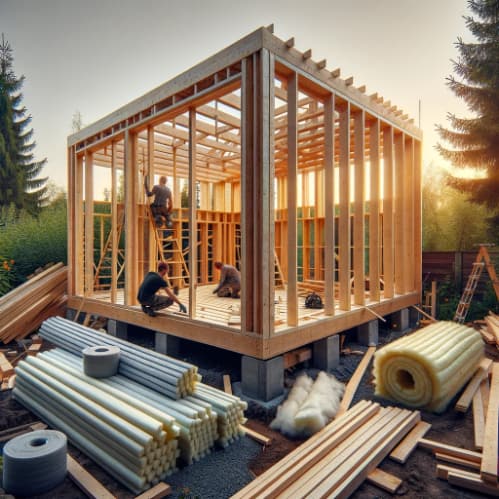Jump to:
Dreaming of having your own tranquil retreat right in your backyard? A garden sauna log cabin could be just the answer. Imagine leaving behind the chaos in a space meant for relaxation and rejuvenation. In this guide, we’ll walk you through the process of creating your own garden sauna oasis. Let’s dive in and turn your backyard into a haven of warmth and relaxation, shall we? If you’re not quite there yet, learn about what a garden sauna cabin is – as well as all the advantages of having one!
1. Planning and preparation
Take a good look around your garden to find the perfect spot for your sauna cabin. Choose an area that’s flat, easily accessible, and offers privacy. Before you start building, research any permits or regulations required in your area. Make sure you’re in compliance with local building codes.
Plan out your budget and make a list of materials you’ll need for the project. This will help you stay organised and avoid any surprises along the way. Consider factors like wood, insulation, and sauna equipment when creating your list.
2. Gathering materials and tools
This material list is a general guideline. Depending on your specific needs and preferences, you may need to adjust or add to it.
Materials
- Wood for framing and cladding (if the log cabin will be built from scratch)
- Insulation material
- Sauna heater and controls
- Ventilation system
- Lighting fixtures
- Weatherproofing treatments
Essential tools
- Hammer and nails
- Screwdriver and screws
- Saw for cutting wood
- Level for ensuring even surfaces
- Tape measure
- Drill for making holes
Look for high-quality materials from reputable suppliers. Consider durability and suitability for outdoor use when selecting wood and insulation. Get recommendations from professionals or check online reviews for trusted sources.
3. Building the foundation

Remove any vegetation, rocks, or debris from the area where your sauna cabin will be located. Use a shovel and rake to level the ground, ensuring it’s flat and even.
Next, build a sturdy foundation for your sauna cabin using a concrete base or a gravel base. Ensure it’s level and provides solid support for the structure. To make an informed choice, you may refer to our ‘How to Choose the Best Summer House Base’ guide.
Install drainage channels or gravel trenches around the perimeter of the foundation. This technique can help divert water away from the garden cabin structure. Incorporate vents for proper air circulation and ventilation inside the sauna.
4. Framing and insulation

Use your design plans as a guide to construct the frame of your sauna cabin. Use sturdy, treated lumber. Also, ensure the structure is square and level before proceeding. Use a carpenter’s square to check corners for 90-degree angles. Measure diagonally across the frame in both directions. Remember, measurements should be equal for squareness. Use a spirit level to ensure horizontal and vertical members are level.
Install log cabin insulation between the framing studs to retain heat inside the sauna cabin. Choose insulation materials suitable for high temperatures and moisture resistance.
Use proper fasteners and techniques to secure the framing members together. Check for any gaps or weak spots in the structure and reinforce as needed. Regularly inspect the garden log cabin for signs of wear or damage. Doing so can help maintain its structural integrity over time.
5. Installing sauna components

Build benches and seating arrangements inside the sauna. Opt for heat-resistant materials like cedar or treated lumber. Both are durable and less prone to warping, cracking, and deteriorating. Ensure the seats are sturdy and comfortable for users. Ensure benches are securely anchored to the walls or floor. Provide adequate spacing between slats for ventilation and comfort.
Position the sauna heater according to manufacturer instructions; connect it to the power. Ensure proper ventilation around it for safety and efficiency. Install ventilation vents near the ceiling to allow hot air to escape. Incorporate lighting fixtures that are moisture-resistant and suitable for high temperatures.
6. Exterior finishing
Cover the exterior walls with weather-resistant materials. Consider cedar siding or treated lumber panels. Both are durable and resistant to moisture, decay, and insects and are suited for outdoor use. Ensure proper installation to protect against moisture and elements.
Apply a weatherproofing treatment, like a sealant or paint, to the exterior surfaces. This will further enhance the durability and resistance to rain, snow, and UV rays. Add aesthetic elements like decorative accents or a coat of paint for enhancement. Or incorporate landscaping around the cabin for a cohesive look with your garden.
7. Interior finishing
Install interior wall panels using heat-resistant materials like cedar. Alternatively, opt for moisture-resistant materials like PVC. Ensure proper fitting to cover framing and insulation for a clean and cohesive look.
Seal joints between panels and around windows and doors to prevent heat loss. Use a suitable sealant or caulk to fill gaps and create a barrier against moisture and drafts. Add accessories like towel racks, hooks, and shelves for convenience. Consider installing a thermometer and hygrometer to monitor temperature and humidity levels. Optimise comfort with seating cushions and ergonomic design elements.
8. Testing, safety checks, maintenance
Prioritise safety by conducting thorough checks of electrical connections and the sauna heater. Ensure all components are properly installed and functioning correctly. Test ventilation systems to ensure efficient airflow and proper circulation of fresh air. This helps prevent overheating and maintains a comfortable environment for users. Verify that your sauna cabin meets all relevant safety regulations and standards, including:
- proper installation of electrical components
- adherence to building codes
- incorporation of safety features like emergency exits
Extend the lifespan of your sauna outdoor cabin with regular cleaning and inspection. Keep electrical components dry and clean ventilation vents. Don’t forget to treat wooden surfaces as needed to protect against moisture and decay. Regular maintenance ensures long-term enjoyment and safety for users.
Round-up
Congratulations on completing your garden sauna cabin! With careful planning and execution, you’ve created a tranquil backyard retreat. Remember to prioritise safety by conducting regular maintenance checks. Also, ensure compliance with safety standards.
Enjoy the warmth and relaxation your sauna cabin brings. Ready to invite friends and family to share in the experience?
For a hassle-free solution, consider our ready-made log cabins for sale. Explore Garden Buildings Direct to discover a range of garden rooms suited to your needs!
Up next on your reading list: What Is a Garden Sauna Cabin?










